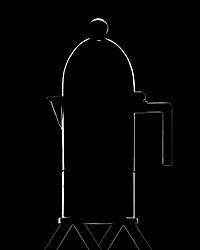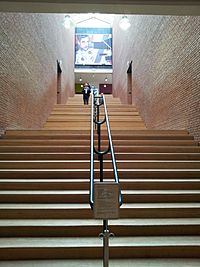Aldo Rossi facts for kids
Quick facts for kids
Aldo Rossi
|
|
|---|---|

Rossi in 1986/87
|
|
| Born | 3 May 1931 Milan, Italy
|
| Died | 4 September 1997 (aged 66) Milan, Italy
|
| Alma mater | Polytechnic University of Milan |
| Occupation | Architect |
| Awards | Pritzker Prize (1990) |
| Buildings | Monte Amiata complex, Teatro Carlo Felice, Teatro La Fenice, Bonnefanten Museum |
Aldo Rossi (born May 3, 1931 – died September 4, 1997) was a famous Italian architect and designer. He became known worldwide for his ideas about architecture, his drawings, and even for designing everyday products. He was a key figure in the "postmodern" style of architecture, which was a new way of thinking about buildings.
Aldo Rossi was the first Italian to win the prestigious Pritzker Prize. This award is like the Nobel Prize for architects.
Contents
Who Was Aldo Rossi?
Early Life and Education
Aldo Rossi was born in Milan, Italy. He went to school with the Somascan Religious Order and later at Alessandro Volta College. In 1949, he started studying architecture at the Polytechnic University of Milan. He finished his studies and graduated in 1958.
While still a student, he began writing for an architecture magazine called Casabella-Continuità. He even became one of its editors. He also wrote for other magazines, showing his strong interest in discussing new ideas about culture and design. His early writings explored the works of other important architects.
Aldo Rossi married Sonia Gessner, a Swiss actress. She introduced him to the exciting worlds of film and theater. His family and culture became very important parts of his life. His son, Fausto, worked in movies, and his daughter, Vera, was involved in theater.
Starting His Career
Rossi began his professional work in architecture offices in 1956. He also started teaching in 1963. He taught at different universities, including the Polytechnic University of Milan and the Institute of Architecture in Venice.
In 1966, he published his famous book, The Architecture of the City. This book quickly became a very important text for architects around the world.
What Buildings Did Aldo Rossi Design?
Early Projects and Fame
Aldo Rossi's career took a big step forward when he helped design part of the Monte Amiata complex in Milan. This was a large housing project.
In 1971, he won a competition to design an extension for the San Cataldo Cemetery in Modena. This project made him famous internationally. He called the cemetery a "city of the dead."
Due to political issues in Italy, he moved to Switzerland for a few years. He taught architectural design at ETH Zurich from 1971 to 1975.
In 1973, he directed the International Architecture Section at the Milan Triennial Exhibition. This was a big art and architecture show. He even made a short film about his ideas for the exhibition. In 1975, he returned to Italy to teach architecture in Venice.
International Recognition
In 1979, Aldo Rossi became a member of the respected Academy of Saint Luke. Around this time, universities in the United States became interested in his work. He taught at places like Cooper Union in New York City and Cornell University. He also traveled to China, Hong Kong, and South America for conferences.
In 1981, he wrote his autobiography, A scientific autobiography. In this book, he shared memories, thoughts, and ideas that shaped his work. That same year, he won a competition to design an apartment building in Berlin, Germany.
He also worked on renovating the Teatro Carlo Felice in Genoa in 1984, which was completed in 1991. He directed the International Architecture Exhibition at the Venice Biennale in 1985 and 1986.
In 1987, he won two more international competitions: one for a park in Paris and another for the Deutsches Historisches Museum in Berlin.
Awards and Later Work
In 1990, Aldo Rossi received the Pritzker Prize, one of the highest honors in architecture. The city of Fukuoka in Japan honored him for his design of The Palace hotel complex. He also won the Thomas Jefferson Medal in Public Architecture in 1991.
His work was shown in major exhibitions at famous museums like the Centre Georges Pompidou in Paris and the Beurs van Berlage in Amsterdam.
In 1996, he became an honorary member of the American Academy of Arts and Letters. He received a special award for his contributions to architecture and design the following year.
Aldo Rossi passed away in Milan on September 4, 1997, after a car accident. After his death, he received more awards for his work in urban studies and for a family home he built in Florida.
His designs were chosen in 1999 for the restoration of the Teatro La Fenice in Venice, a famous opera house that reopened in 2004. In 1999, the architecture school at the University of Bologna was named after him.
Aldo Rossi's Architectural Style
Rossi's early ideas in the 1960s were very important. He was influenced by Italian modernism from the 1920s and the ideas of artists like Giorgio de Chirico. He also visited the Soviet Union to study their architecture, which left a strong impression on him.
In his writings, Rossi believed that architects often didn't fully understand cities. He argued that a city should be seen as something that has grown and changed over a long time. He was especially interested in old buildings and monuments that have lasted through history. Rossi thought that cities "remember" their past through these monuments, which give the city its structure. He wanted to design buildings that would also last and become part of a city's memory.
His ideas became very influential in the late 1970s and 1980s. His books, The Architecture of the City and A Scientific Autobiography, helped spread his theories.
The unique style of his buildings can also be seen in the smaller products he designed. In the 1980s, Rossi designed coffee makers and other items for companies like Alessi and Pirelli. His La Cupola espresso maker for Alessi, released in 1988, is a famous example.
Exhibits and Special Projects
For the Venice Biennale in 1979, Rossi designed a floating theater called Teatro del Mondo. It could seat 250 people. For the 1984 Venice Biennale, he designed a large arch at the entrance to the exhibition. In 2006, two tall structures based on his 1989 design were built in front of the Bonnefanten Museum in Maastricht.
Awards and Recognition
Aldo Rossi won the prestigious Pritzker Prize in 1990. A famous architectural critic, Ada Louise Huxtable, described Rossi as "a poet who happens to be an architect." This means his designs were not just functional but also beautiful and thoughtful, like poetry.
Key Architectural Works
Here are some of the important buildings and projects Aldo Rossi designed:
- 1967-74 Monte Amiata complex in Milan, Italy
- 1971-84 Ossuary and the Cemetery of San Cataldo in Modena, Italy
- 1979 The floating Teatro del Mondo for the Venice Biennale
- 1979 Apartments in Südliche Friedrichstadt, Berlin, Germany
- 1981-1988 Berlin Block in Berlin, Germany
- 1984-1991 Renovation of Teatro Carlo Felice in Genoa, Italy
- 1986-1989 Palace Hotel in Fukuoka, Japan
- 1991 Contemporary arts center on the island of Vassivière, France
- 1994-1998 Schützenstraße quarter in Berlin, Germany
- 1995 Bonnefantenmuseum in Maastricht, Netherlands
- 1996-1998 Mojiko Hotel in Kitakyushu, Japan
- 1999-2004 Refurbishment of Teatro La Fenice in Venice, Italy
- 2001 Scholastic Corporation Headquarters in New York City, USA
Product Designs
Besides designing buildings, Aldo Rossi also created many everyday products:
- 1982 The Conical coffee maker and kettle for Alessi
- 1983 Teatro chair for Molteni Group
- 1988 La Cupola coffee maker for Alessi
- 1988 Il Conico tea kettle for Alessi
- 1989 Paris chair for Unifor
- 1989 Moment clock for Alessi
Images for kids
-
Bonnefanten Museum, Maastricht (1990–94)
See also
 In Spanish: Aldo Rossi para niños
In Spanish: Aldo Rossi para niños











